Knowing how to change a tire is a necessary skill for all drivers. If you rely on a cell phone to save you in a roadside emergency, there’s always that chance you will forget to charge it, be out of range, or leave it at home. Flat tires can happen anywhere, and a cell phone is no substitute for knowing how to change a flat tire.
Thankfully, changing a tire isn’t all that hard! Just adhere to the following guidelines to be prepared in case you have a flat.
These items should have come with your vehicle:
Jack
Lug wrench
Fully inflated spare tire
Vehicle owner’s manual
If you have misplaced any of these items, or if your car did not come with these items, you should purchase new ones right away. And be sure you’re regularly inflating the spare tire to your vehicle manufacturer’s recommended PSI. You should check the spare’s air pressure every time you check your other tires.
Remember to check pressure every month and before long trips or carrying extra load.
Here are some items that don’t come with your vehicle but that you should stow in your trunk or glove box in case you have to change a flat tire:
Flashlight with working batteries
Rain poncho
Small cut of 2"x6” wood to secure the jack
Gloves
Wheel wedges
As soon as you realize you have a flat tire, do not abruptly brake or turn. Slowly reduce speed and scan your surroundings for a level, straight stretch of road with a wide shoulder. An empty parking lot would be an ideal place. Level ground is good because it will prevent your vehicle from rolling. Also, straight stretches of road are better than curves because oncoming traffic is more likely to see you.
Never attempt to change your tire on a narrow shoulder near oncoming traffic. Keep moving (slowly) until you find a safer spot. While driving on a flat risks ruining your rim, replacing a rim is better than being hit by an inattentive driver.
Make sure to consult your owner’s manual and review their specific steps on how to change a flat tire for your vehicle
Your hazard lights or “flashers” will help other drivers see you on the side of the road. To avoid an accident, turn them on as soon as you realize you need to pull over.
Once stopped, always use the parking brake when preparing to replace a flat tire. This will minimize the possibility of your vehicle rolling.
Wheel wedges go in front of or behind the tires to further ensure the vehicle doesn’t roll while you fix the flat tire. If you’re changing a rear tire, place these in front of the front tires. If your flat tire is at the front, put the wheel wedges behind the rear tires.
Bricks or large stones will work just as well as “real” wheel wedges. Just be sure they’re large enough to stop the car from rolling.
If your vehicle has a hubcap covering the lug nuts, it’s easier to remove the hubcap before lifting the vehicle with the jack. If your lug nuts are exposed, you can skip ahead to Step 6.
If your lug nuts are exposed, you can skip ahead to Step 6.
Use the flat end of your lug wrench to remove the hubcap. This will work for most vehicles, but some hubcaps need a different tool to come off. Consult your owner’s manual for proper hubcap or wheel cover removal procedures.
Using the lug wrench, turn the lug nuts counterclockwise until you break their resistance. You may have to use force, and that’s ok. Use your foot or all of your body weight if necessary.
Loosen the lug nuts about ¼ to ½ of a turn, but don’t remove them completely yet. Save that for when it’s time to remove your tire/wheel from the vehicle.
The right place for the jack is usually beneath the vehicle frame alongside the tire that’s flat. Many vehicle frames have molded plastic on the bottom with a cleared area of exposed metal specifically for the jack. To safely lift and avoid damage to the vehicle, follow the instructions for jack placement in your vehicle owner’s manual.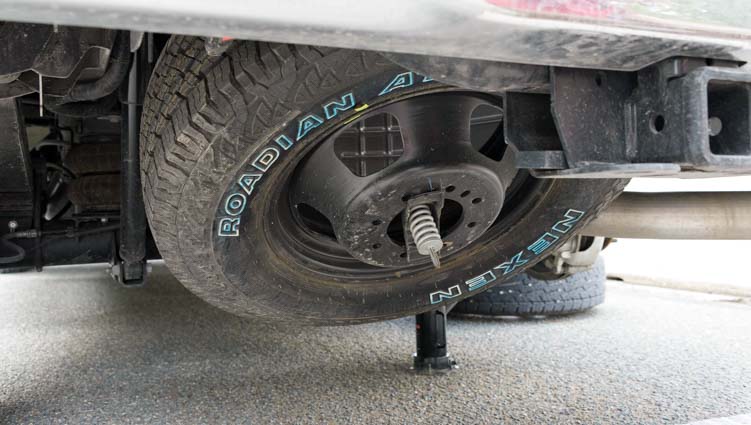
To prevent the jack from settling under the weight of your vehicle and coming off balance, place a small cut of 2x6” wood beneath it before attempting to raise your vehicle. This tactic is especially helpful on asphalt.
With the jack properly positioned, raise the vehicle until the flat tire is about six inches above the ground.
Never put any part of your body under the vehicle during or after raising the vehicle with the jack.
Now it’s time to remove the lug nuts all the way. Since you've already loosened them, you should be able to unscrew them mostly by hand.
Gripping the tire by the treads, pull it gently toward you until it’s completely free from the hub behind it. Set it on its side so that it doesn’t roll away.
Now place the spare on the hub by lining up the rim with the lug bolts. Push gently until the lug bolts show through the rim.
Put the lug nuts back on the lug bolts and tighten them all the way by hand. Once they are all on, check each one again, tightening as much as possible. You will tighten them with the wrench after lowering the vehicle to the ground.
Use the jack to lower the vehicle so that the spare tire is resting on the ground but the full weight of the vehicle isn’t fully on the tire. At this point, you should tighten the lug nuts with the wrench, turning clockwise, as much as you can. Push down on the lug wrench with the full weight of your body.
Bring the vehicle all the way to the ground and remove the jack. Give the lug nuts another pull with the wrench to ensure they’re as tight as possible.
If the hubcap you took from the flat tire will fit your spare, put it in place the same way you removed it initially.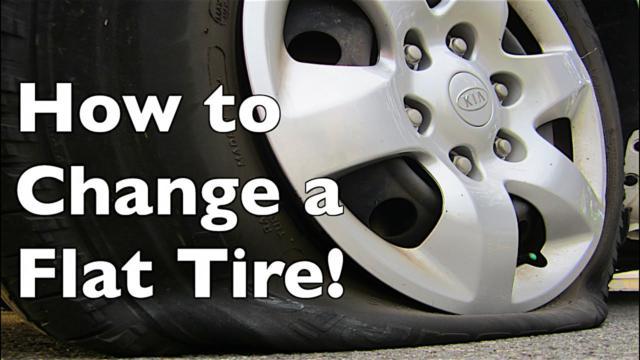 If it doesn’t fit, stow it away with the tire when you stow your equipment.
If it doesn’t fit, stow it away with the tire when you stow your equipment.
You have before you a jack, a lug wrench, wheel wedges, your flat tire, and possibly a hubcap. Don’t forget to put all of them in your vehicle before driving away.
You should check the tire pressure of the spare tire to make sure that it is safe to drive on. “T-Type” temporary spares, also called “mini-spares,” require 60 psi (420 kPa). If the tire needs pressure, drive (slowly) to a service station immediately.
Temporary spare tires aren’t made to drive long distances or at high speeds, so drive cautiously until you’re able to visit a tire technician. A professional should be able to determine whether your tire needs a repair or if it’s time to replace it.
Aside from taking your tire to a professional, the above procedure shouldn’t take more than 15 to 30 minutes to change a tire.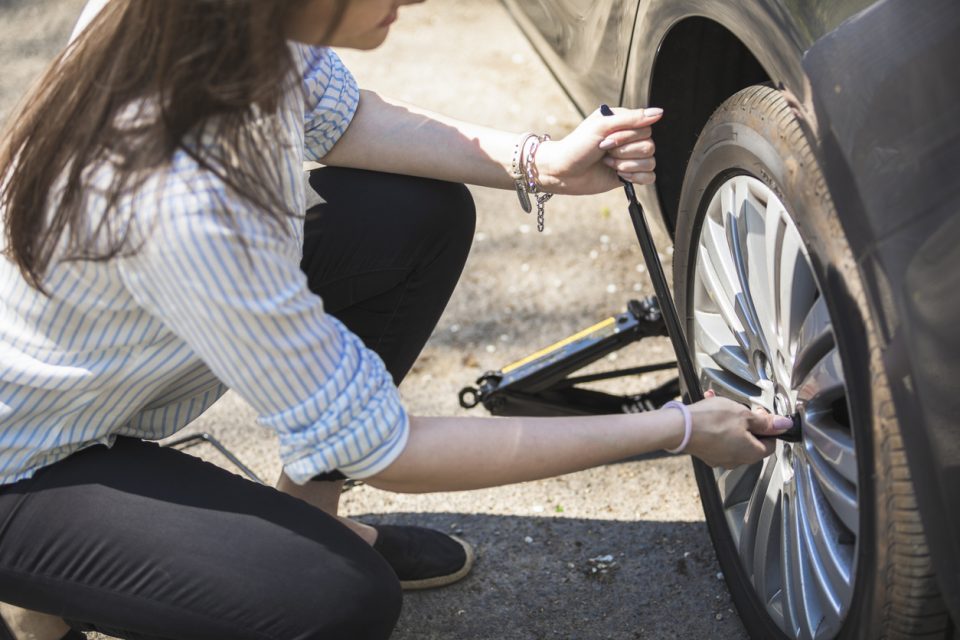 Just be sure you don’t leave out any steps.
Just be sure you don’t leave out any steps.
It’s beneficial practice changing a tire in your garage or driveway to ensure you’re ready to handle this situation if it ever happens to you.
Knowing how to fix a flat tire is great, but regular tire maintenance is even more important. In addition to reviewing this guide regularly, remember to do the following:
Keep your tires properly inflated
Rotate your tires according to the manufacturer’s guidelines
Monitor for tread wear
All of these precautions will extend the life of your tires and reduce the likelihood of a flat. While there’s no way to prevent flat tires completely, proper care can improve performance and ensure your tires last as long as possible.
There’s never a good time for a flat. That’s why Bridgestone DriveGuard tires are masterfully engineered to keep you moving for up to 50 miles at speeds up to 50 MPH without disruption.
There’s never a good time for a flat. That’s why Bridgestone DriveGuard tires are masterfully engineered to keep you moving for up to 50 miles at speeds up to 50 MPH without disruption.
See Details Find Your Fit
| Afraid to take off your rear wheel to fix a flat tire (or when taking off both wheels to put a bike in a car trunk)? Worried that you'll mess up the chain or shifting; or that you'll get all greasy? Think you'll never get the rear wheel back on right? We have good news: Anyone can remove and install a rear wheel and it won't affect the shifting or the chain. And if you work carefully, you won't have to touch that greasy drivetrain either. Here's how it's done on any bicycle with derailleurs, from road bikes, to mountain bikes and any 2-wheelers in between. Watch the videos and review the step-by-step photos and text. We're also happy to demonstrate in person, too, so please let us know if you'd like a quick lesson. We've covered all the tips and tricks, so you'll be an expert in no time! |
WHEEL REMOVAL 1, 2, 3!
1. Shift onto the small cog and small chainring.
Shifting the chain down onto the smallest cog on the rear wheel and the smallest chainring on the crankset, creates slack in the chain, which makes rear wheel removal much easier. It also makes wheel installation easier because it gives you an accurate way to line up the wheel (on the smallest cog) so that it slips right into the bicycle frame.
If you're riding and feel the rear tire becoming soft slowly from a puncture, you may have time to make the shifts to the smallest cog and ring as you're slowing to a stop.
If you're not riding, or have already stopped, operate the right shift lever, lift the bike by the seat and pedal by hand and the chain will move down the cogs in the back. Depending on the type of shift lever, you may need to move the lever a couple of times to move the chain onto the smallest cog.
Now, do the same with the left shift lever and pedal by hand and get the chain onto the smallest chainring in front, too.
2. Open the brake
Note: If you're fixing a flat tire, you needn't worry about this step because when the air is all out of the tire it will fit through the brake easily. Also, if your bike has disc brakes, you too can skip this step because you don't need to touch disc brakes to remove wheels.
On most bikes with rim brakes, when you try to remove the wheel, the tire bumps into the brake pads.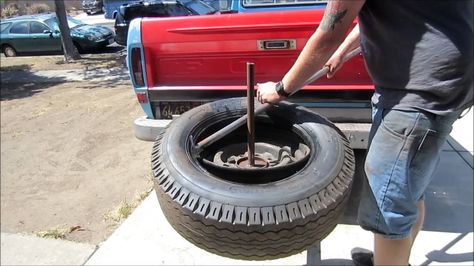 This is because the brake needs to be adjusted close to the rim, while the fully inflated tire is significantly wider than the rim.
This is because the brake needs to be adjusted close to the rim, while the fully inflated tire is significantly wider than the rim.
To prevent the tire bumping into the brake pads, you can open sidepull brakes by fully rotating the little lever on the brake upwards (photo a). This little lever is called the brake quick release for the way it lets you quickly release (open) the brake pads. For linear-pulls (also called "direct-pulls," and "V-brakes") lift/pull the end of the "noodle" out of its holder (photo b).
Some sidepulls are opened by pressing a button on the lever. Look for this if there's no lever on the brake.
Open cantilever brakes (these feature a cable that runs over the top of the tire) by lifting the cable end on one side out of its holder.
Workarounds: If you can't find a way to open a brake, you can also let air out of the tire until you can pinch it enough to squeeze it through the brake pads. Another trick - though it requires tools and time - is to remove one brake pad which will often provide sufficient clearance.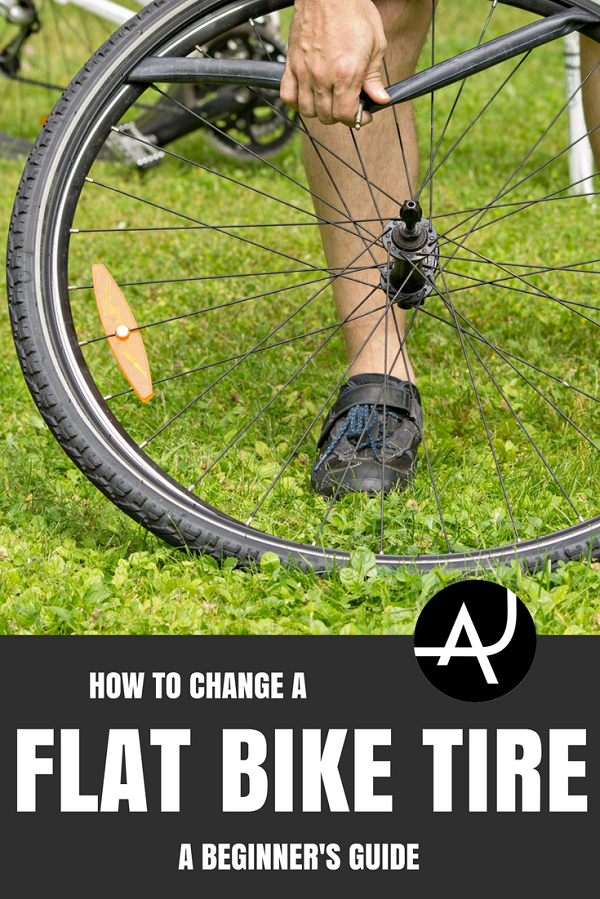 If not, you can remove both pads. Just be sure to remount them carefully so that they contact the rim squarely and don't touch any part of the tire.
If not, you can remove both pads. Just be sure to remount them carefully so that they contact the rim squarely and don't touch any part of the tire.
3. Pull the derailleur back and remove the wheel
Now you're ready to remove the wheel. Most bicycle wheels have quick releases holding them in the frame (the red parts in the photo). To open the quick release and loosen the wheel, simply pull and fully open the lever, which is usually on the opposite side of the chain. Don't twist the lever. Just pull it out/away from the frame.
When the quick release is open, the wheel is ready to come out. To remove it, lift the bike by the seat so that gravity will help you. On some bikes the wheel will drop right out at this point (don't let it roll down the road and escape!). Or, if it doesn't fall out on its own, give it a slight blow with your hand and that might knock it right out.
Don't force anything though. If the wheel doesn't come out right away, it's because the derailleur and chain are blocking it. To get them out of the way, keep holding the rear end of your bike off the ground by lifting the bike by the seat. Reach down with your free hand and pull back the derailleur with your hand to get it, and the chain, out of the way.
To get them out of the way, keep holding the rear end of your bike off the ground by lifting the bike by the seat. Reach down with your free hand and pull back the derailleur with your hand to get it, and the chain, out of the way.
Now, the wheel should fall out or drop out if you shake the bike. If the chain gets in the way still, just grip the wheel and shake it so that it's free of the chain and fully off the bike (that way you never touch the chain and stay clean). Good job!
Note: To clearly show the desired derailleur position, we locked it in place. You must pull it back by hand when removing wheels because it won't stay in place on its own.
How to put the rear wheel back on
| As you guessed, installing the rear wheel is the same as removal only in the reverse order! You just place the wheel back in the frame being careful to get the chain on the right cog, close the quick release to lock the wheel in, and close the brake so your brakes are working again. The video shows front and rear wheel installation in that order. We go over the step-by-step below and explain some of the things that can go wrong and how to deal with them. It can be frustrating if the wheel won't go in easily. But there's always a mechanical reason. So, look at what you're doing carefully and read our instructions a few times and you should be able to find the problem and address it so that the rear wheels goes right back where it belongs. |
If your wheel won't go in easily, check these things:
Did you get the chain on the cog right? Remember that you shifted the chain onto the smallest rear cog before you removed the wheel. So, you must put the wheel back on by first lining that smallest cog up just right so that the chain is on it. Also, pay attention to how the chain rests on the cog. The chain is a closed loop. The cog should be inside the loop (see the photo in Step 3).
The chain is a closed loop. The cog should be inside the loop (see the photo in Step 3).
Note: If the wheel has been off the bicycle for some time, it's possible that someone might operate the shift levers. This can move the derailleur so that when you line up the wheel with the smallest cog the wheel won't go into the frame. Instead it bumps into the frame. To remedy this and get the wheel in, simply operate the shift lever as if you're shifting onto the smallest cog. This will move the rear derailleur back where it needs to be so that the wheel will line up right with the frame and go in.
Did the chain come off the derailleur pulley? Another glitch that can prevent the wheel going right into the frame is if the chain happens to come off the top pulley on the derailleur (photo). This is hard to see but it has a similar effect to someone shifting the derailleur into the wrong position and it makes the wheel run into the frame and not want to go in. To fix it, just push the chain back onto the pulley and make sure it stays there as you install the wheel. Tip: Use a stick to push it on or wrap your finger in a rag and you'll stay grease-free.
To fix it, just push the chain back onto the pulley and make sure it stays there as you install the wheel. Tip: Use a stick to push it on or wrap your finger in a rag and you'll stay grease-free.
Is your quick release still open? Sometimes when the wheel is separate from the bike, the quick release lever gets bumped and flipped over and closed. When this happens the wheel won't fit in the frame anymore because the quick release is closed and in the way. Open it and the wheel will fit.
Now that you know how it's done, you may want to practice removing and installing your rear wheel a few times to become expert at it so that when you have to do it, it's a breeze. And, so you can dazzle your friends by helping them remove/install their wheels! Have fun and let us know if you'd like a demo.
There is nowhere without a bicycle in the country. In the truest sense of the word, there is nowhere to go. Not for bread, not for screws, not for matches. Also, if you don't have a car. And if there is a car, and the driver tasted fragrant apple calvados in the morning? You have to walk, which takes a lot of time. And if there is a bicycle, he jumped on it, and in a few minutes there would be bread, and screws bought, and matches mined. Therefore, not only must bicycle transport be at your disposal, but besides, it must always be in good order, ready at any time to deliver you on urgent matters.
In the truest sense of the word, there is nowhere to go. Not for bread, not for screws, not for matches. Also, if you don't have a car. And if there is a car, and the driver tasted fragrant apple calvados in the morning? You have to walk, which takes a lot of time. And if there is a bicycle, he jumped on it, and in a few minutes there would be bread, and screws bought, and matches mined. Therefore, not only must bicycle transport be at your disposal, but besides, it must always be in good order, ready at any time to deliver you on urgent matters.
While conducting a spring revision of my old high-speed bike, we found an "eight" on the rear wheel - a change in its geometry. The rim was bent so much that it constantly brushed against the brake pads, making it impossible to drive safely.
First, we decided to tighten the spokes. There are special ways to do this at home. For those who are interested, it is enough to search the Internet for how to fix the G8. Upon closer inspection, it was found that a pair of spokes was missing. The plastic protection of the spokes installed on the wheel makes it difficult to install new ones, so it must be completely disassembled.
The plastic protection of the spokes installed on the wheel makes it difficult to install new ones, so it must be completely disassembled.
Turn the bicycle upside down, unscrew the eccentric clamp nut, remove the eccentric itself from the hole in the axle, release the footrest, remove the chain and wheel. In this case, you need to loosen the brake pads and release air from the wheel so that the tire does not cling to them.
Unscrew the nipple, pull out one side of the tire, carefully prying it with a flat screwdriver, without tearing the chamber. Get the camera, then remove the tire.
Now you need to remove the asterisk. It is impossible to do this without a special puller, so we took care of buying it in advance.
Insert the puller inside the sprocket and unscrew it with a gas wrench. By the way, any key for 24 can be suitable for these purposes.
Here another trouble was discovered - the rim was worn to the hole. Repair it was impossible, so I had to go to the store for a new one.
Repair it was impossible, so I had to go to the store for a new one.
Our speed bike had a single rim wheel. Almost all modern cycle bikes are equipped with double rim wheels. It is believed that they are stronger and more reliable. The price difference is not very big, so we listened to the seller and bought a copy with a double rim.
At first, the plan for replacing a rear wheel on a speed bike seemed simple: screw the sprocket onto a new one, insert the tube, tire and install on the bike. But upon closer inspection, it turned out that the axles of the wheels are different. The old one has a hole inside for the eccentric, and the new one does not.
Therefore, I had to rearrange the axle from the old wheel to the new one. This requires 2 keys. We hold the locknut with one, and unscrew the second with the other. Having unscrewed, remove the washer and unscrew the lock nut, which is the bearing boot. While loosening the nut, watch out for balls that may fall out of the resulting gap.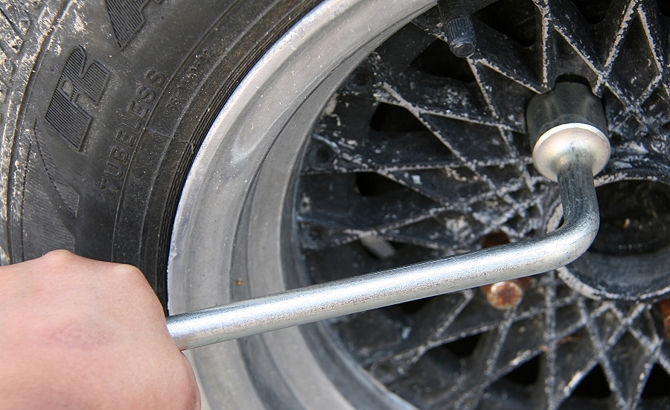 Now you can take out the axle.
Now you can take out the axle.
In the same way, remove the axle from the new wheel. The grease in it is fresh, thick, so the bearing balls, having stuck to it, were in their place.
Carefully, adding fresh grease, insert the axle with the eccentric hole onto the new wheel and tighten the nuts in reverse order.
Tighten the bearing cone nuts until there is no play in the carriage, but at the same time the wheel rotates freely. On both sides of the axle, at the edges, we leave a space equal to 1 cm so that it fits into the lugs of the rear fork of the bicycle. This distance is adjusted by a washer in the form of a sleeve. Tightening the second nut, we fix the first one with a key so that it does not move, otherwise the wheel will spin with effort.
Then we assemble everything in the reverse order. We install the protection of the spokes, with the help of a puller we twist the sprocket.
Fill the tire on one side, insert the tube, fill the tire completely. We inflate the chamber with a pump, then bleed the air so that it falls into place.
We inflate the chamber with a pump, then bleed the air so that it falls into place.
Now we take the wheel, put the chain on the sprocket and install the axle in the fork lugs. The tire, pressing on it, must be inserted between the brake pads.
Install the footrest, insert the eccentric clamp and secure it with the nut.
Adjust the brakes by attaching the pads near the rim. We pump up the camera and do a test drive. This completes the replacement of the rear wheel of a sports bike. If you liked the article, share it on social networks.
Contents
The reasons for replacing a wheel can be very different - from frequent nail penetration or “snake bite” by the edge of the rim to updating the wheel and transferring the old proven tube to it. There is no difficulty in how to change the camera on a bicycle. Consider how to do this, and what you may need in the process.
There is no difficulty in how to change the camera on a bicycle. Consider how to do this, and what you may need in the process.
If we change the camera in "ideal" conditions, we already have a garage ready, a tool kit, a repair kit and a new camera. Unfortunately, not everything is always so “successful”. It may turn out that the camera burst on the street during a long race or even in competitions.
The simplest option is to carry the chamber and pump with you. Not every damage can be sealed, and the easiest way is to change the whole camera. The only negative of this kit is the weight and volume. The sealing kit is a small box, but the “spare tire” is already a serious piece of rubber that can get in the way in a small bag, if you have one at all.
Unfortunately, the condition of the roads and the general susceptibility of modern bikes to damage mean that you can't travel further than the city center without a spare bike tube or repair kit.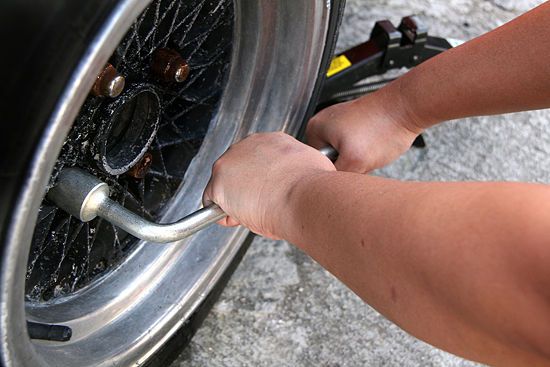 What will be needed to replace in the minimum version?
What will be needed to replace in the minimum version?
With these tools, you can easily disassemble the rear wheel, remove the camera and install a new one in its place.
The repair kit is worth considering separately. Many never open it from the moment of purchase, but in fact you can assemble it yourself. Homemade repair kit comes out several times cheaper.
What is in the repair kit?

Actually, all parts of the repair kit can be assembled by yourself. Old cameras are used for patches, cleaning is done with ordinary sandpaper, glue is sold in any store, and ordinary alcohol is a degreaser.
Recently, some people use anti-puncture gels, and it is enough to pour sealant into a new chamber before pumping it up and carefully “disperse” it along the inner cavity of the chamber.
Repair kit with beading, but without glue
Those who have changed the tube with their own hands know, perhaps, the main problem is the bending of the tire bead. Modern tires adhere so well to the rim and are so stiff that it is not always possible to do this by hand.
Modern tires adhere so well to the rim and are so stiff that it is not always possible to do this by hand.
That's why many multi-tools or kits include a break-down. These are small plastic or metal "spoons" that are inserted between the tire and rim, allowing you to pry and bend the tire, and then put it back on.
So, what are the steps to follow to change the camera. Everything is simple, the main thing is accuracy and a small amount of physical strength.

So, the camera is removed, you can repair it or print a new one. Installing everything back:
That's it, the replacement is done! As you can see, there is nothing complicated in this process.
Tube replacement is a simple process that every cyclist should be prepared for. A puncture on the road, damage to the camera in the forest, or just updating a bicycle wheel - it's always nice to deal with the problem yourself and quickly, and not carry the bike on yourself to the workshop.